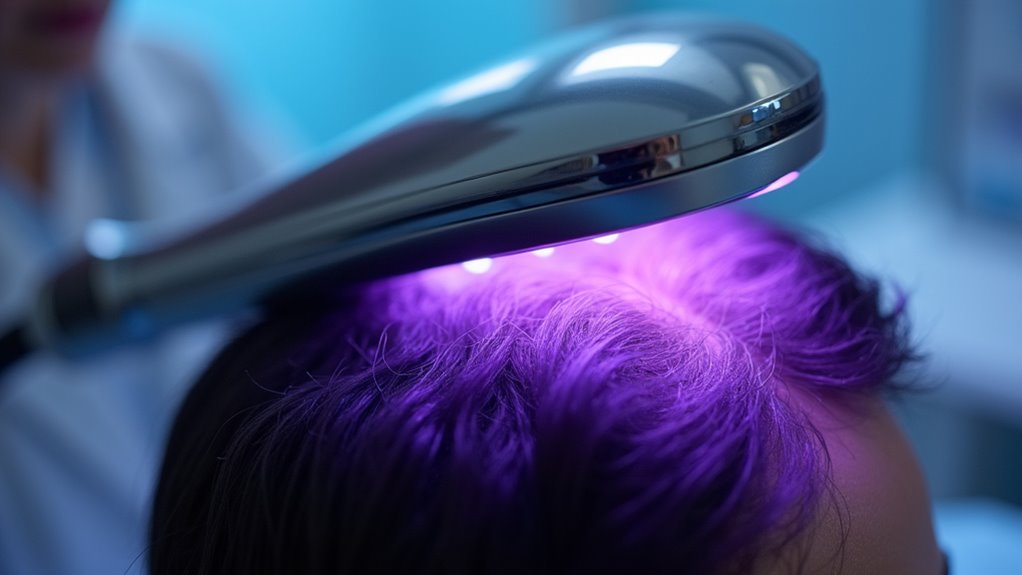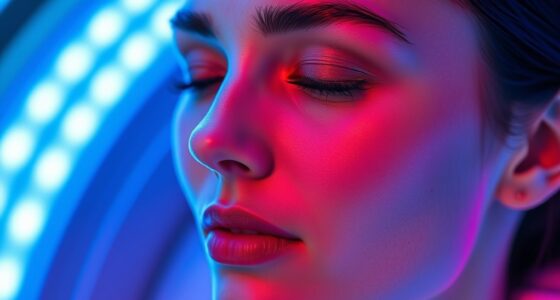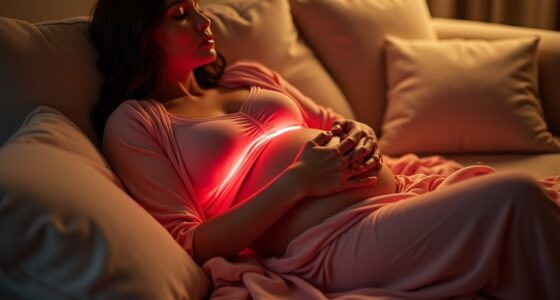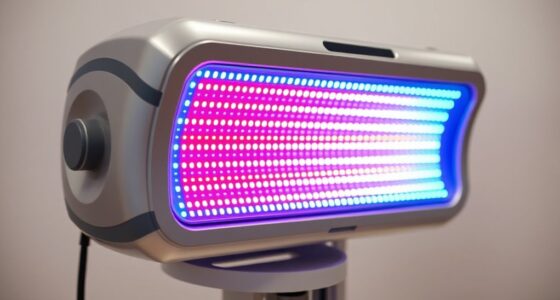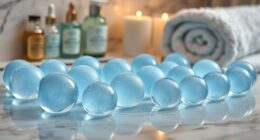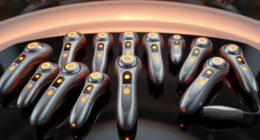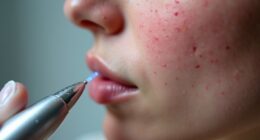LED therapy stimulates hair follicles by delivering specific wavelengths of light that boost cellular activity, blood flow, and reduce inflammation. Scientific studies show that this treatment can increase hair density, thickness, and overall health by supporting natural growth and preventing follicle miniaturization. It’s a safe, non-invasive option with promising results, especially when traditional methods don’t work. Keep exploring to understand how this innovative approach could help you achieve healthier hair.
Key Takeaways
- Scientific studies indicate LED therapy can increase hair density and follicle health through cellular stimulation.
- Red and near-infrared light penetrate scalp tissue, promoting blood flow and reducing inflammation, supporting hair growth.
- Clinical trials demonstrate LED therapy’s potential to reverse miniaturization and activate dormant hair follicles.
- Users report improved hair thickness and overall scalp health with consistent LED treatment.
- While generally safe and effective, long-term research and standardized protocols are still needed for conclusive evidence.
Understanding How LED Therapy Works on Hair Follicles
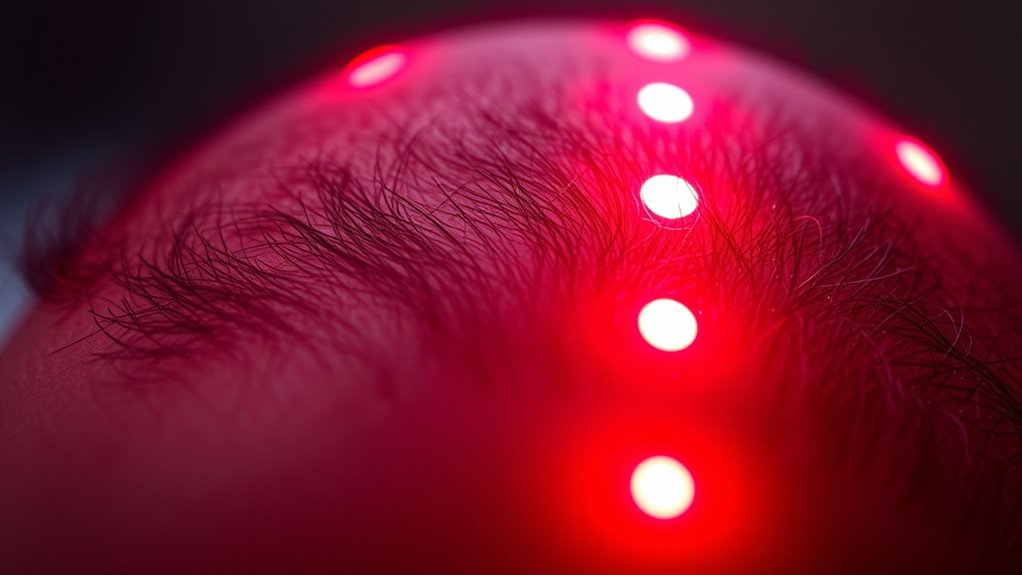
LED therapy works by delivering specific wavelengths of light directly to your scalp, where it stimulates the hair follicles. This process is known as photobiomodulation therapy, a technique that enhances cellular activity within the follicles. When you undergo LED treatment, the light penetrates the skin and activates the cells responsible for hair growth. The light energy boosts blood flow, reduces inflammation, and encourages follicle activation, helping dormant or weakened follicles regain strength. This targeted approach makes LED therapy effective for addressing hair thinning and promoting healthier hair. As you continue treatment, you’ll notice improved follicle function and increased hair density. Photobiomodulation therapy offers a non-invasive way to support your hair growth journey, harnessing light’s power to stimulate your scalp naturally.
The Types of Light Used in Hair Growth Treatments
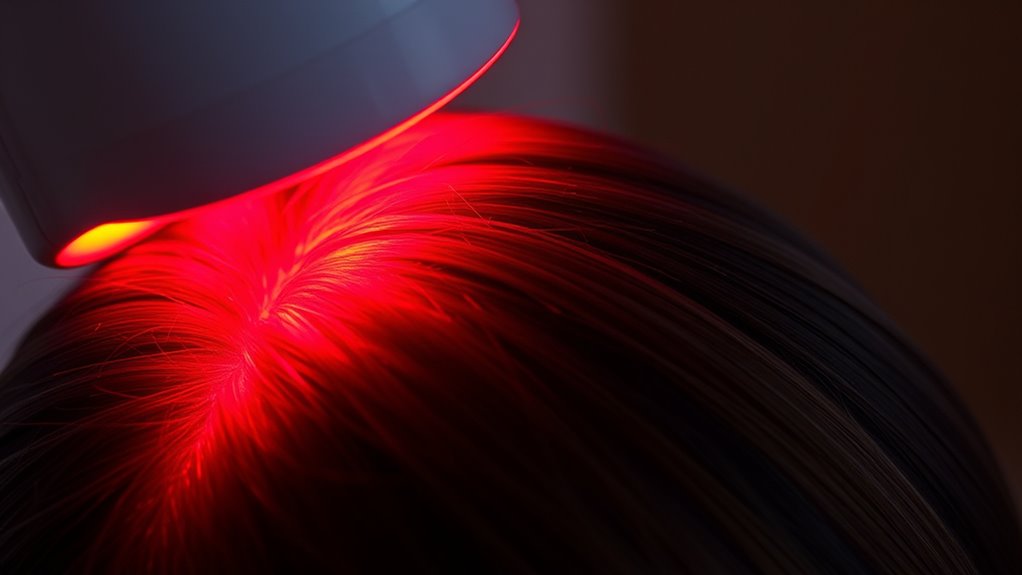
Different wavelengths of light are used in hair growth treatments to target specific cells within the scalp. The most common light wavelength is red light, typically around 630-670 nanometers, which stimulates hair follicles and promotes cell activity. Near-infrared light, around 800-900 nanometers, penetrates deeper, enhancing blood flow and healing damaged tissue. Different device types, such as laser caps, combs, and LED panels, deliver these wavelengths effectively. The choice of device depends on your needs and treatment preferences. Some devices focus on delivering specific light wavelengths for targeted therapy, while others combine multiple wavelengths for broader benefits. Understanding the light wavelength and device type helps you choose the most suitable option for boosting hair growth through LED or laser therapy.
Key Studies Supporting LED Therapy for Hair Loss
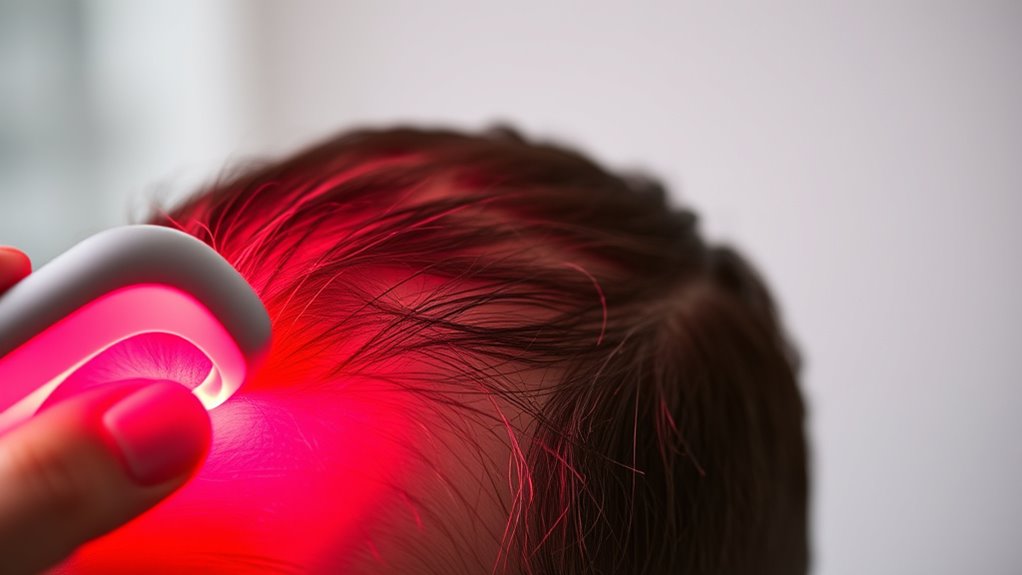
Numerous scientific studies have demonstrated the effectiveness of LED therapy in promoting hair growth and reducing hair loss. These studies provide strong evidence supporting its use as a viable treatment option. When considering cosmetic branding, highlighting these key research findings can strengthen your marketing strategies, making your products more credible and appealing to consumers. For example, clinical trials showing increased hair density and improved follicle health help position LED therapy as a scientifically backed solution. Incorporating such data into your marketing materials builds trust and differentiates your brand in a competitive market. As you communicate these benefits, emphasize the scientific validation behind your treatments to attract customers seeking proven, effective hair loss solutions. Additionally, understanding the biological mechanisms of LED therapy can further enhance your credibility by demonstrating how it interacts with follicular cells to stimulate growth.
Evaluating the Quality and Limitations of Current Research
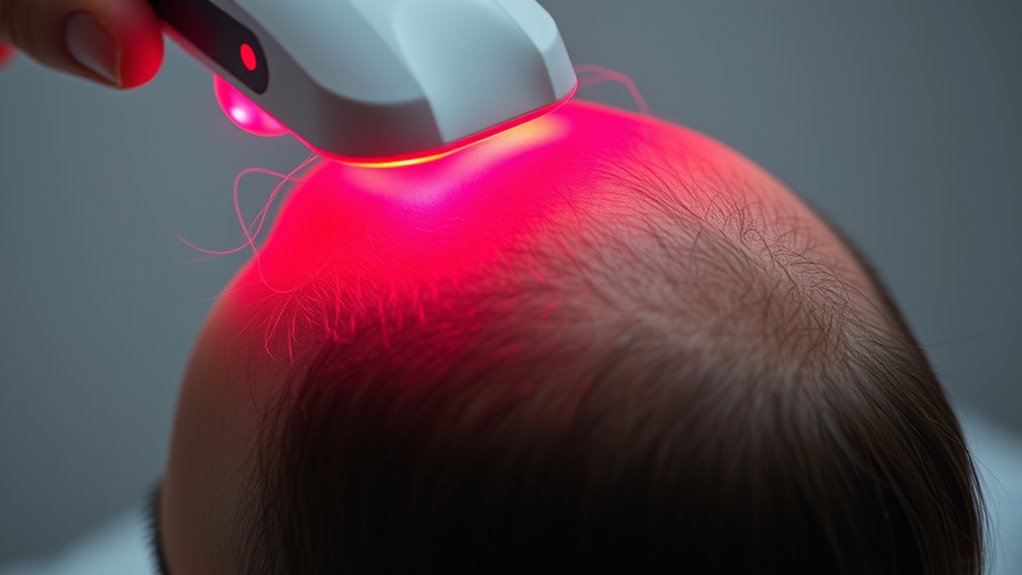
When evaluating current research on LED therapy for hair growth, you should consider the size of study samples, as small groups may not provide reliable results. Methodological consistency across studies is also vital, since variations can affect the validity of the findings. Additionally, the lack of long-term data limits your understanding of the therapy’s sustained effectiveness and safety. Furthermore, reviewing research methodologies can help determine the overall reliability of the studies.
Study Sample Sizes
Many studies on LED therapy and hair growth involve relatively small sample sizes, which can limit the reliability of their findings. Small sample sizes mean fewer participants, making it harder to generalize results to a larger population. Participant diversity is also often limited, reducing the applicability across different ages, genders, or hair types. When sample sizes are too narrow, the study might not capture the full range of responses to LED treatment. This can lead to overestimating or underestimating its effectiveness. To draw stronger conclusions, larger, more diverse samples are essential. They help ensure the results are more representative and less influenced by individual variations, providing a clearer picture of LED therapy’s true potential for hair growth. Additionally, the study design and methodology influence the reliability of findings, emphasizing the need for well-constructed research.
Methodological Consistency
Evaluating the quality and limitations of current research on LED therapy and hair growth reveals significant inconsistencies in methodology. Many studies lack standardized protocols, making comparisons difficult. You should be cautious of the placebo effect, which can skew results if blinding isn’t rigorous. Device safety also varies, with some studies neglecting long-term safety assessments. These inconsistencies hinder definitive conclusions about LED therapy’s effectiveness.
| Aspect | Concern |
|---|---|
| Study Design | Lack of double-blind, placebo-controlled trials |
| Sample Size | Often too small to be conclusive |
| Device Safety | Insufficient long-term safety data |
Long-term Data Availability
Current research on LED therapy for hair growth often falls short in providing long-term data, leaving gaps in understanding its sustained safety and effectiveness. This data scarcity makes it hard to confidently assess whether LED treatments maintain results over time. Without robust long-term studies, you can’t be sure about the therapy’s lasting impact or potential side effects. Key issues include:
- Limited follow-up periods in existing studies
- Inconsistent reporting of long-term outcomes
- Small sample sizes restricting generalizability
- Furthermore, understanding the role of creative practice in designing better studies could help address these research gaps by fostering innovative approaches to data collection and analysis.
These limitations hinder accurate evaluation of long term effectiveness, emphasizing the need for more thorough, extended research. Until more all-encompassing data emerges, you should remain cautious about expecting lasting results from LED hair therapy.
Comparing LED Therapy to Other Hair Loss Treatments
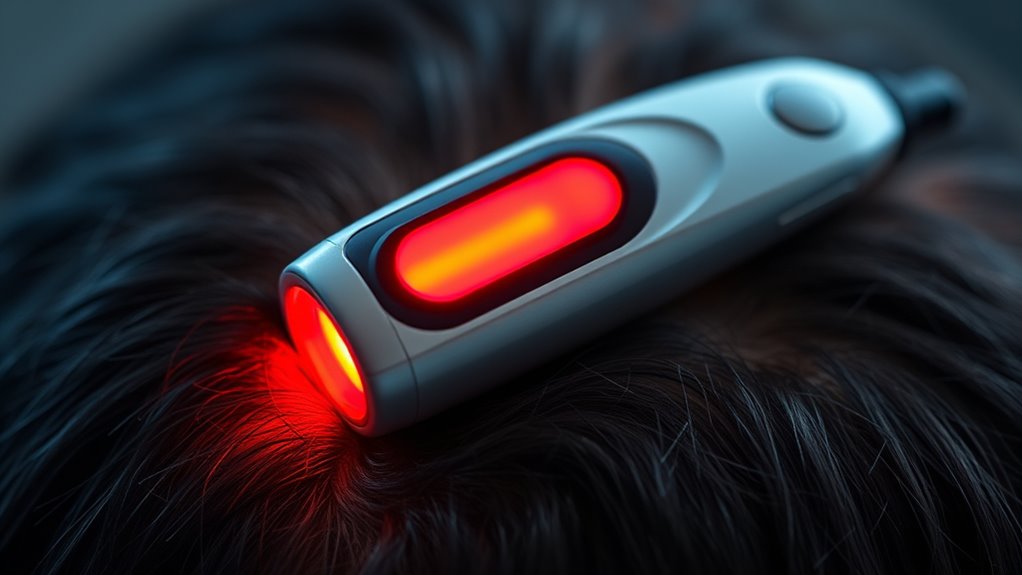
LED therapy offers a non-invasive alternative to traditional hair loss treatments, making it appealing for those seeking safer options. Compared to medications like minoxidil or finasteride, LED therapy has fewer cosmetic concerns and fewer side effects, which many find reassuring. Unlike surgical options such as hair transplants, LED therapy doesn’t involve downtime or scarring. While topical solutions focus on stimulating scalp circulation or blocking hormones, LED therapy uses light to promote cellular activity. For aesthetic applications, LED therapy provides a gentle, pain-free approach, making it suitable for individuals hesitant about invasive procedures. Though it may require consistent, long-term use, many find its safety profile and ease of use justify its place alongside other treatments. Ultimately, comparing these options helps you choose what’s best for your hair health and confidence.
Potential Mechanisms Behind LED-Induced Hair Regrowth
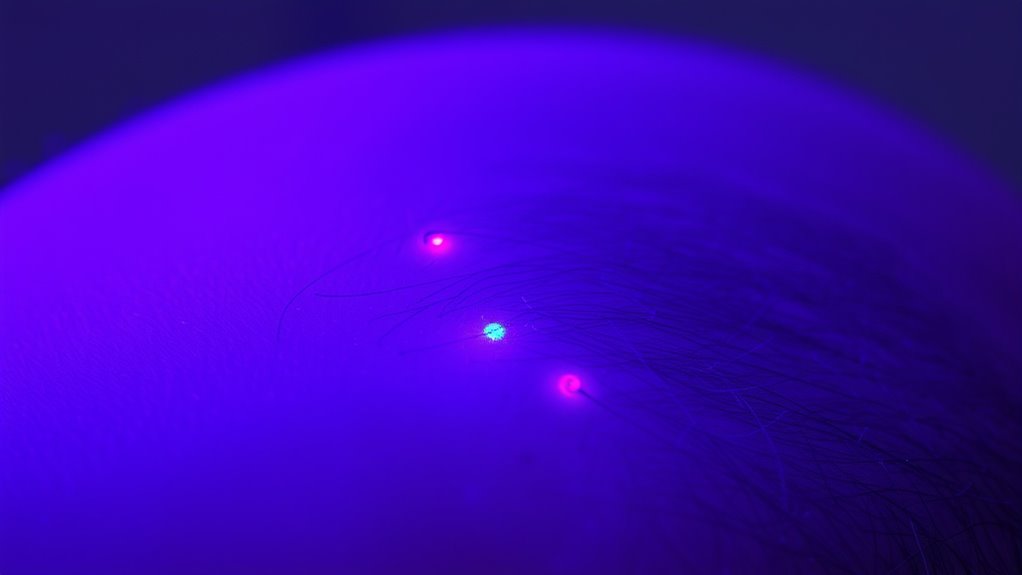
LED therapy may boost your hair growth by increasing cellular metabolism in hair follicles. It also stimulates these follicles directly, encouraging new growth. Additionally, it helps reduce inflammation, creating a healthier environment for hair to thrive. Research suggests that improving blood circulation may further enhance nutrient delivery to hair follicles, supporting sustained growth and health.
Enhances Cellular Metabolism
By stimulating cellular activity, light therapy can boost the metabolic processes within hair follicle cells, promoting healthier and more robust hair growth. This increase in cellular metabolism is similar to effects seen in photorejuvenation and skin tightening treatments, where enhanced cell function improves tissue health. When you undergo LED therapy, it encourages energy production at the cellular level, supporting repair and regeneration. This process helps make hair follicles more efficient at producing hair. Additionally, the increased metabolic activity can reduce inflammation and oxidative stress, creating a healthier environment for hair growth. Research also indicates that LED therapy’s ability to optimize cellular functions plays a crucial role in promoting hair regeneration.
Stimulates Hair Follicles
How exactly does light therapy stimulate hair follicles to promote growth? When you expose your scalp to LED light, it interacts with hair follicle cells, boosting their activity. This process can influence hair color by stimulating pigment cells, making hair appear darker or healthier. Additionally, LED therapy raises scalp temperature slightly, increasing blood flow and nutrient delivery to follicles. This combination encourages follicle regeneration and prevents miniaturization. Moreover, the UV spectrum emitted by LED devices can further enhance cellular activity and support the hair growth process.
Reduces Inflammation Effects
Inflammation in the scalp can hinder hair growth by damaging hair follicles and disrupting their normal function. LED therapy helps reduce this inflammation, promoting healthier conditions for hair growth. By calming the scalp, it supports skin rejuvenation, which restores the scalp’s natural barrier and reduces irritation. This process can also provide pain relief, easing discomfort caused by inflammation. Additionally, understanding personality traits can help tailor treatment approaches to individual needs and responses.
You can benefit from LED therapy’s ability to:
- Decrease swelling and redness, creating a healthier environment for follicles
- Accelerate skin rejuvenation, improving scalp resilience
- Alleviate scalp pain, making treatments more comfortable
Reducing inflammation allows hair follicles to recover and thrive, making LED therapy a promising approach for those battling inflammation-related hair loss.
Safety and Side Effects of Using LED Devices
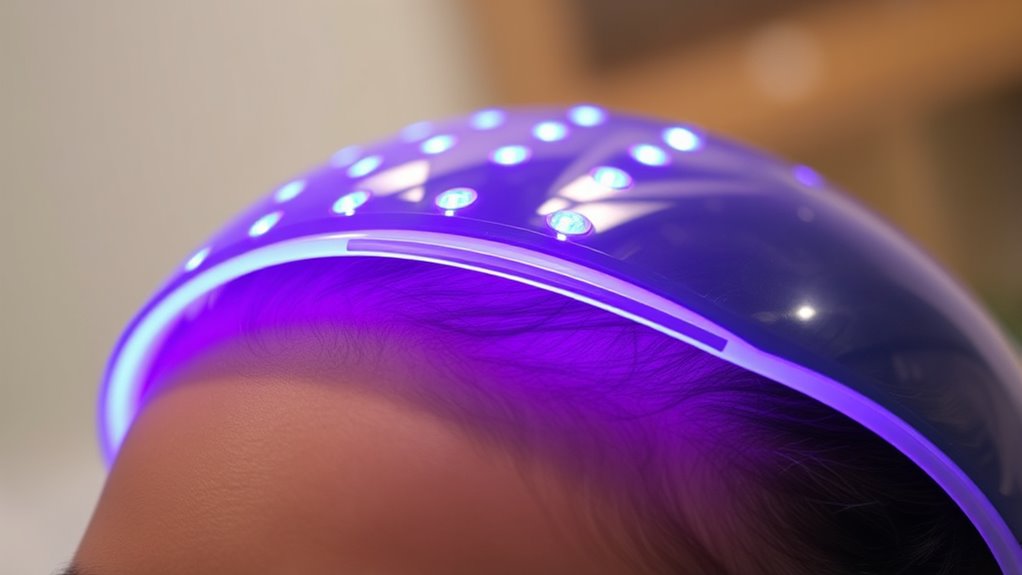
Although LED therapy is generally considered safe for most users, it’s important to be aware of potential side effects and precautions. While serious issues are rare, some may experience mild skin irritation or redness after use. To guarantee safety, check the device’s durability; poorly made devices might malfunction or deliver inconsistent light, reducing effectiveness. Additionally, consider cost considerations, as higher-quality devices often come with a higher price but may offer better safety features and longevity. Avoid overuse or improper handling to prevent burns or eye strain. Always follow manufacturer instructions and consult a healthcare professional if you have skin sensitivities or underlying conditions. Being cautious helps maximize benefits while minimizing risks associated with LED hair growth devices. Understanding proper Toilet Maintenance and Repairs can also prevent unexpected issues during treatment routines.
User Experiences and Clinical Outcomes
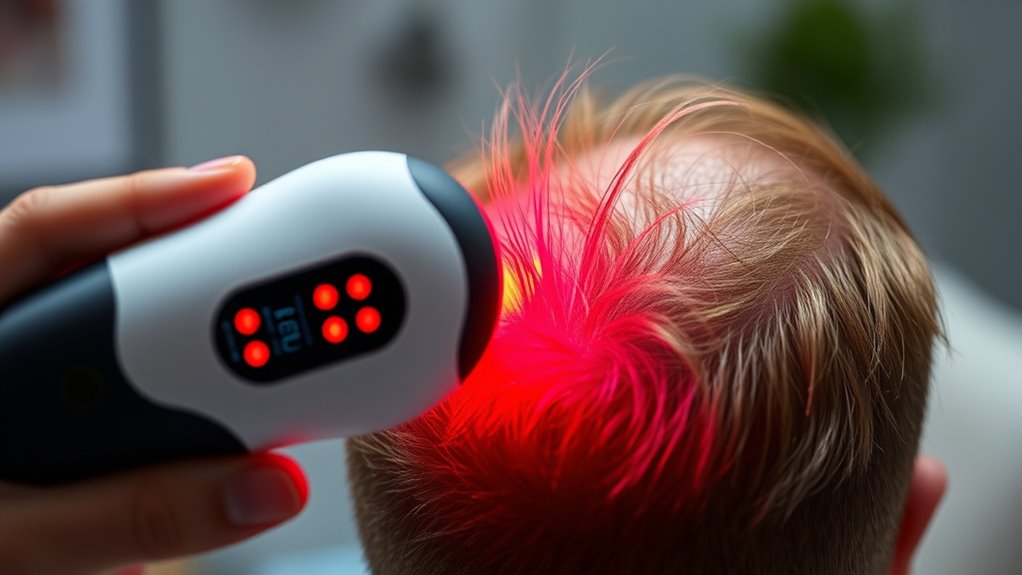
Many users report noticeable improvements in hair density and thickness after consistent use of LED therapy devices. They often find LED therapy to be a promising alternative treatment, especially when traditional options haven’t yielded results. Users notice that their hair feels fuller and looks healthier, boosting confidence and simplifying hair styling routines. Clinical outcomes generally support these experiences, showing increased hair count and improved follicle health over time. Some common observations include:
- Reduced hair shedding and thinning
- Enhanced hair strength and shine
- Positive feedback from those seeking non-invasive solutions
Additionally, couples traveling together have reported that engaging in activities like LED therapy sessions can be a bonding experience, fostering shared wellness goals. If you’re exploring alternative treatments, LED therapy offers a convenient, non-chemical option that could complement your hair styling routine while encouraging healthier growth.
Future Directions in LED Hair Growth Research

Building on the positive results reported by users and supported by clinical data, researchers are now exploring new frontiers in LED therapy for hair growth. One key area is the development of innovative wavelengths that target different scalp layers and hair follicle conditions more effectively. These new wavelengths could enhance treatment outcomes and reduce recovery times. Additionally, there’s a focus on treatment customization, allowing therapies to be tailored to individual hair loss patterns, skin types, and response rates. Advances in technology may enable personalized LED devices, optimizing light intensity, duration, and wavelength for each person. This personalized approach aims to maximize hair growth benefits while minimizing side effects, paving the way for more effective and accessible solutions in future hair restoration treatments.
Making an Informed Decision: Is LED Therapy Right for You?
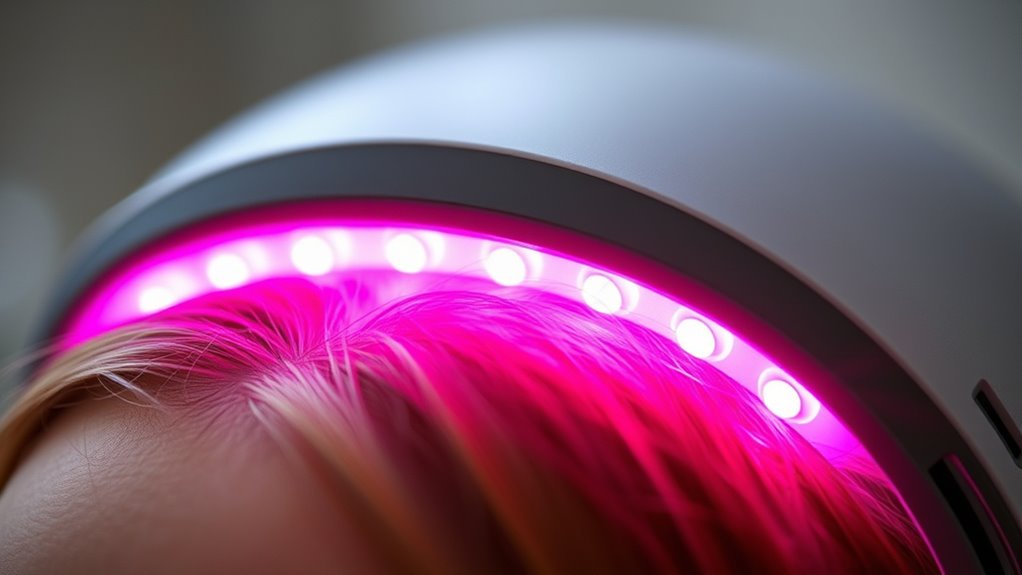
Are you wondering if LED therapy is the right choice for your hair loss situation? It’s important to weigh how this treatment fits your goals and expectations. LED therapy is used in cosmetic applications for its potential to stimulate hair growth and improve scalp health. It also offers aesthetic benefits, like enhancing the overall appearance of your hair and scalp. Before deciding, evaluate factors such as your hair loss pattern, underlying causes, and whether you’re comfortable with ongoing treatments. Consulting a healthcare professional can help determine if LED therapy aligns with your needs. Keep in mind that individual results vary, and understanding these aspects ensures you make an informed decision about incorporating LED therapy into your hair care routine.
Frequently Asked Questions
How Long Does It Typically Take to See Results From LED Hair Therapy?
When you start LED hair therapy, your timing expectations matter. Typically, you might begin to see visible results after about 8 to 16 weeks of consistent treatment. Keep in mind, everyone’s response varies, and patience is key. Regular sessions are essential to achieve the best outcomes. Stay committed, and you’ll increase your chances of noticing positive changes in hair thickness and growth over time.
Can LED Therapy Be Combined With Other Hair Loss Treatments?
Imagine transforming your hair loss journey into a powerhouse of results by combining treatments! Yes, LED therapy can be seamlessly integrated with other hair loss therapies, creating a dynamic combo that maximizes hair growth potential. Combination treatments and therapy integration allow you to target hair thinning from multiple angles, boosting effectiveness. Always consult your specialist to develop a personalized plan that combines these methods safely and effectively for the best possible outcome.
Are There Any Long-Term Risks Associated With Regular LED Device Use?
You’re likely wondering about the long-term safety of regular LED device use. While current research suggests these devices are generally safe, it’s important to take into account device regulation and proper use. There’s limited data on potential long-term risks, so sticking to reputable, regulated devices and following manufacturer guidelines helps minimize any concerns. Overall, with responsible use, LED therapy appears safe for ongoing hair growth treatments.
Is LED Therapy Effective for All Types of Hair Loss Causes?
Think of LED therapy as a versatile tool, like a key that opens different doors. It can effectively address some hair loss causes, such as androgenetic alopecia, by stimulating follicles. However, for other causes like scalp conditions or hormonal issues, treatment options may vary in success. You’ll find LED therapy helpful mainly for specific hair loss causes, but consulting a specialist guarantees you choose the right treatment options for your unique situation.
What Is the Cost Comparison Between LED Therapy and Traditional Treatments?
When comparing LED therapy to traditional treatments, you’ll find that device durability varies, with LED devices often lasting longer and requiring less maintenance. Costs for LED therapy can be upfront but may be more affordable over time, especially since insurance coverage usually doesn’t include it. Traditional treatments like medications or hair transplants tend to be more expensive and often have insurance options, making them potentially costlier overall.
Conclusion
While LED therapy shows promise in stimulating hair growth, it’s not a miracle cure—yet. As studies highlight potential, they also remind you of the limited long-term data and varying results. It’s tempting to hope for a simple solution, but managing expectations is key. You weigh the hope of fuller hair against the reality of ongoing research, knowing that patience and proper care remain your best allies in this journey.
